In his final days, Jimmy Carter on cusp of a humanitarian goal: Eradicating a parasitic worm
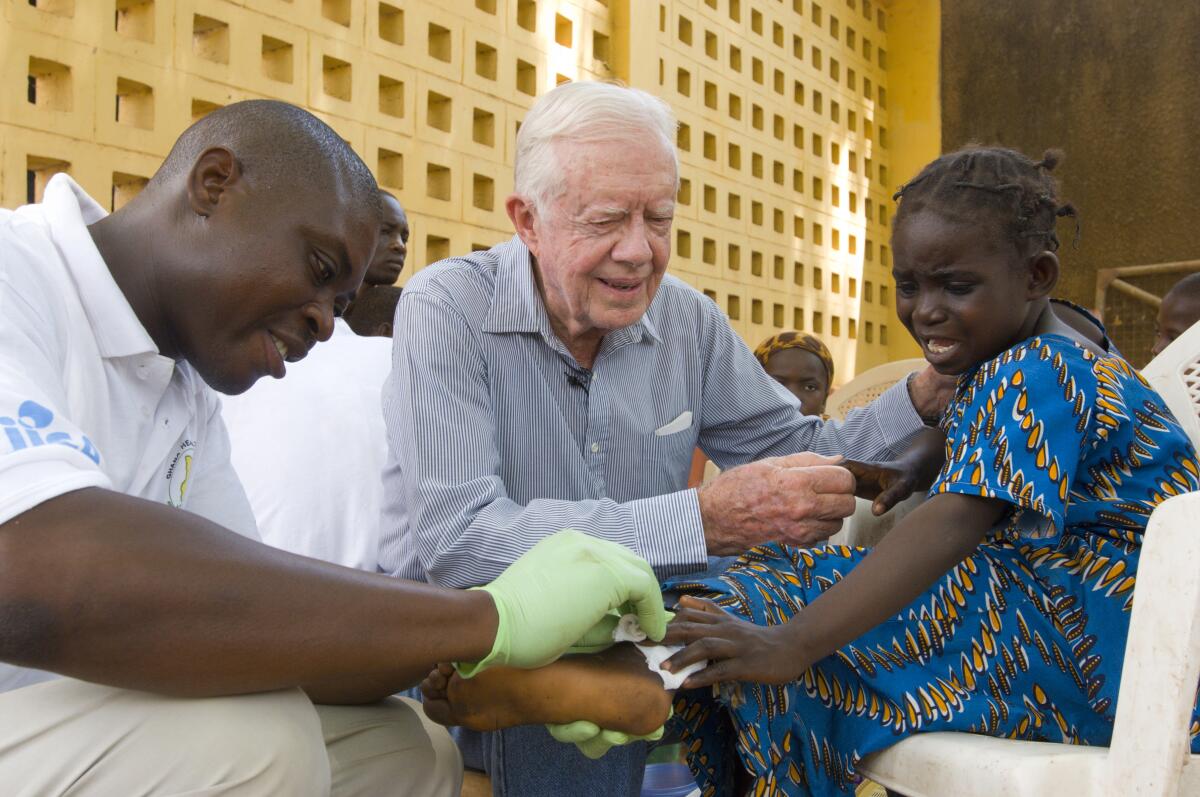
- Share via
ATLANTA — Just a few hours before President Carter underwent his first radiation treatment for brain cancer, he spoke of his hope, in the time he had left, to purge the world of a parasitic worm disease.
That was in 2015.
“I’d like the last Guinea worm to die before I do,” the 39th president told reporters at the Carter Center. “We know where all of them are, so obviously that would be my top priority.”
Carter had set up the global Guinea Worm Eradication Program in 1986, when about 3.5 million people across rural Africa and Asia were afflicted by the excruciating parasite that has plagued humans for thousands of years.
The 98-year-old, now in hospice at home in Plains, Ga., is on the cusp of reaching his goal: The number of reported human cases dwindled in 2022 to 13 — an all-time low.
“We’ve joked many times: Who’s going to win — the Guinea worm or Jimmy Carter?” said Dr. Peter Bourne, Carter’s former drug czar who became an assistant secretary-general at the United Nations. “Thirteen is pretty close to zero. For the millions of people who didn’t get the Guinea worm infection, he has had an enormous impact.”
At a transitional moment in U.S. history, President Carter opted to emphasize human rights in U.S. foreign policy, shaking up the establishment and altering the conversation ever since.
One of the outstanding achievements of the Carter presidency was the 1979 peace settlement between Israel and Egypt. Decades later, the prospect of peace in the Middle East is dismal, and Carter’s most enduring global legacy could be making Guinea worm the second infectious human disease to be eradicated, after smallpox in 1980.
“His role was crucial,” Bourne said. “He would call people like the president of Ghana and say, ‘I want to talk to you about Guinea worm.’ It was difficult enough to get the minister of health on the phone, and to get a president to talk about Guinea worm was no easy feat. But they would all respond to him.”
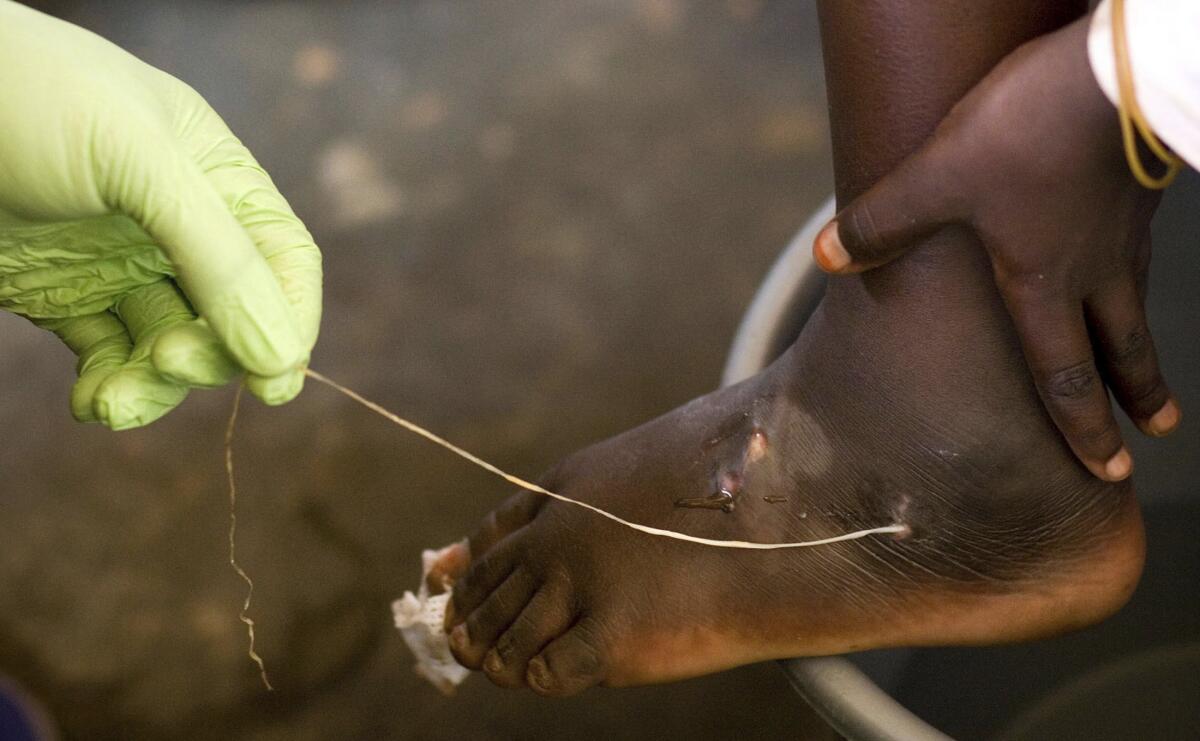
The Latin name of Guinea worm disease — Dracunculiasis — means “affliction with little dragons.” The calcified remains of the worm have been found in a 3,000-year-old Egyptian mummy of a 13-year-old girl, and some scholars believe they may have been the “fiery serpents” the Old Testament describes as attacking the Israelites in the desert.
Humans contract the parasite after drinking stagnant water infested with tiny crustaceans that have swallowed microscopic Guinea worm larvae. After an incubation period of about a year, the larvae grow into noodle-like worms up to 3 feet long that wrap around tendons, ligaments and connective tissue. They release a burning acid that blisters the skin, allowing them to poke their head out of a leg, foot or arm, and in some cases a breast or scrotum.
The worm’s exit is so agonizing that it prevent kids from going to school and adults from farming, cooking and collecting firewood. Ridding the body of the parasite takes weeks. First, the worm is wrapped onto a rolled piece of gauze or stick. Then the stick is twisted to slowly pull out the worm, about an inch a day.
In 1988, Carter encountered the Guinea worm for the first time in the village of Denchira near Accra, the Ghanian capital. About half the village’s 500 inhabitants were infected, some so crippled that they could not leave their huts. Carter spotted a young woman he thought was cradling a baby in the crook of her right arm, but when he approached, he realized she was not holding an infant.
“Her right breast, which was about more than a foot long … had a Guinea worm emerging from the nipple,” Carter said in 2016.
“Well, we can’t leave them like this,” Carter said after his visit to Denchira.
The Carter Center worked with the Ministry of Health to bring every known intervention to the village, said Dr. Donald R. Hopkins, who led the center’s efforts to eradicate the disease from 1987 to 2015. Nearly a year and a half later, Carter went back to Denchira to find the parasite almost gone.
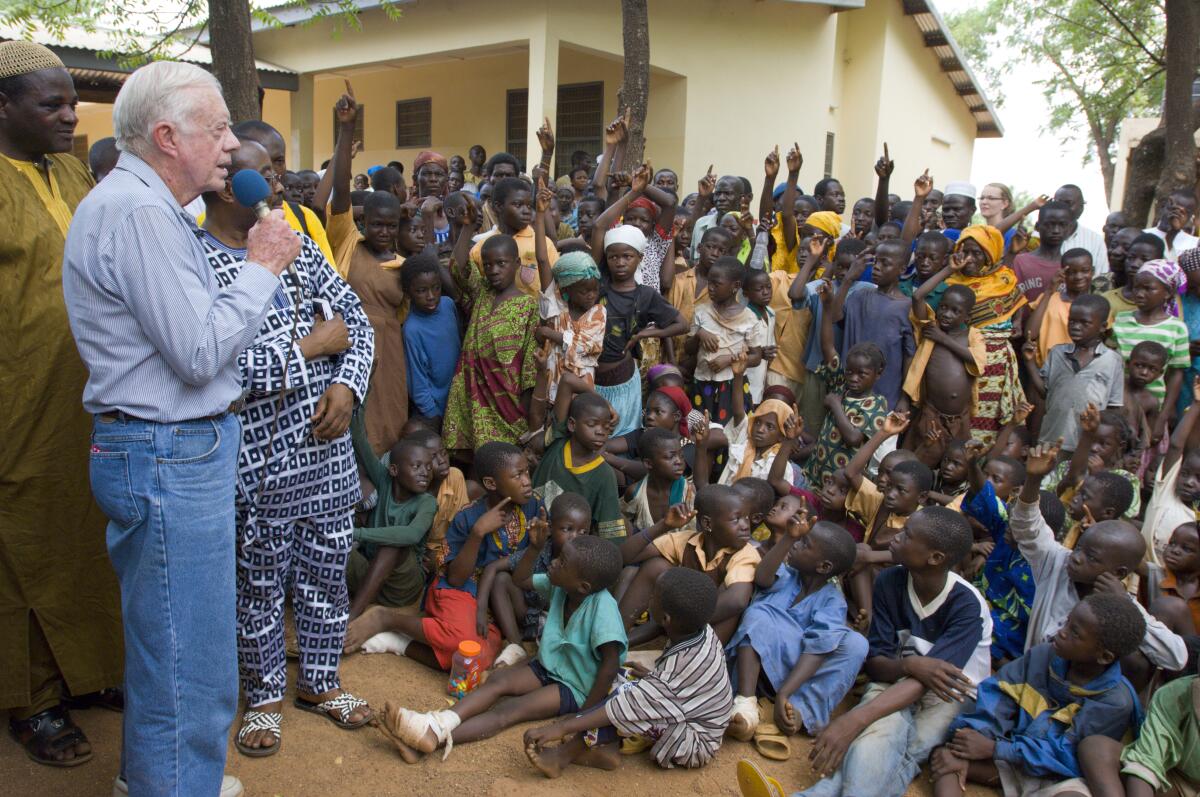
Adam Weiss, the director of the center’s Guinea Worm Eradication Program, said Carter would try to console patients and hold their hands as they shrieked when the worm emerged.
“It’s one of those problems that once you see it, you can’t unsee it,” Weiss said. “Even some of the most stoic men in South Sudan, this brings them to their knees. They cry. They don’t want to admit it, but they do. It’s something you can’t walk away from.”
Over the years, Carter’s visits to rural Africa inspired thousands of schoolchildren to line highways to see him. In Nigeria, Carter said, a group of children held a big sign that said, “Watch out, Guinea worm, here comes Jimmy Carter!”
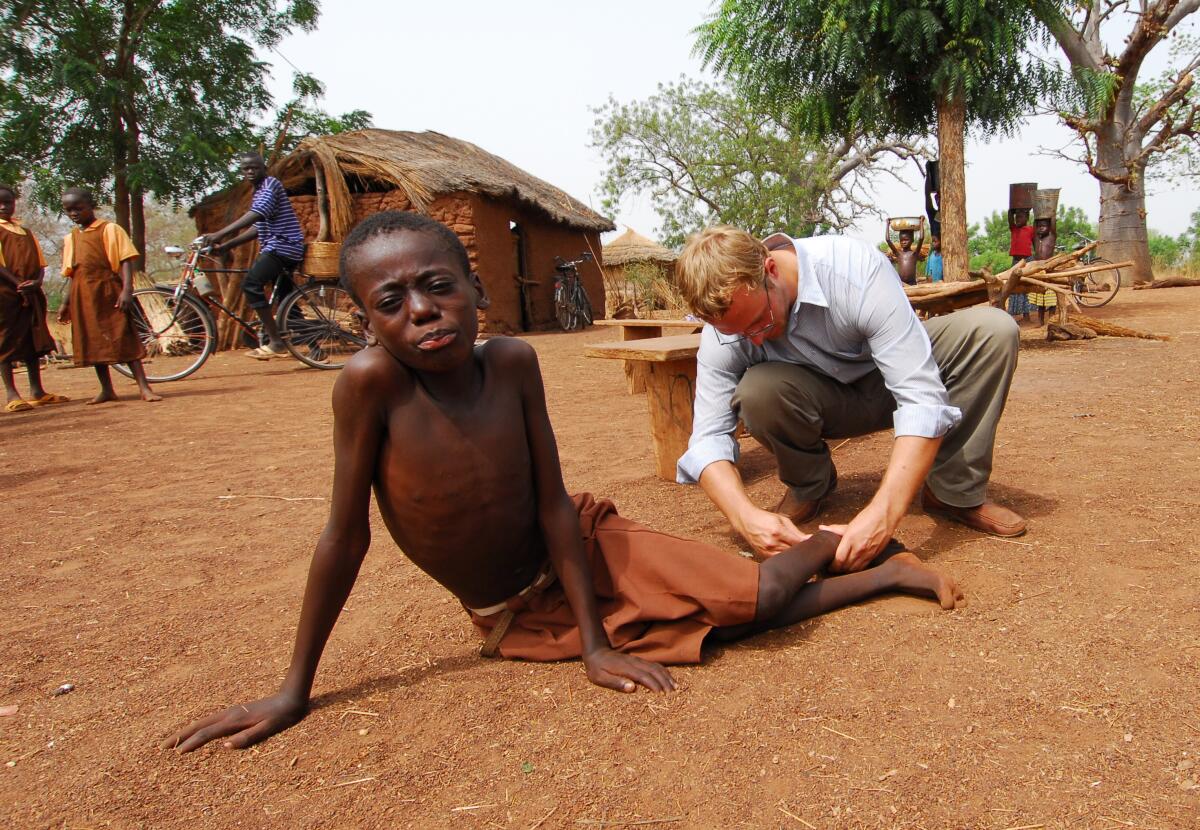
Carter first considered the possibility of eradicating Guinea worm when he was in the White House. As smallpox was on the verge of being eliminated in 1977, Carter asked Bourne if there was any other disease that could have the same impact.
Bourne told Carter that the Guinea worm would probably be the easiest global infectious disease to eradicate: Unlike smallpox, it could be eliminated without a medicine or vaccine. Prevention could be achieved by showing villagers how to make their water supply safe — filtering drinking water and preventing the infected from walking into stagnant ponds and spreading larvae — coupled with vigilant monitoring of the disease.
But there was a problem: Guinea worm disease did not exist in the United States.
“We decided that the Guinea worm was so obscure that no one in the U.S. would pay attention,” Bourne said. “I thought that he isn’t going to want to use up any political credit.”
That calculus changed when Carter left the White House in 1981 and a year later founded the Carter Center. By that point, Bourne was working at the United Nations, heading a 10-year program to provide people around the world with clean drinking water.
Joe Biden had a ringside seat for Jimmy Carter’s presidency — its failures as well as its sometimes unappreciated successes. Here’s what he may have learned.
After speaking at the Carter Center on the importance of clean drinking water, Bourne said he hosted the Carters on a trout fishing vacation at his farm in Wales and asked the former president to be the figurehead for the campaign to fight the parasitic disease.
“I told him: You could eradicate Guinea worm in your lifetime,” Bourne said. “It’s something that would have global impact, and you don’t have to worry about doing it just for a U.S. audience.”
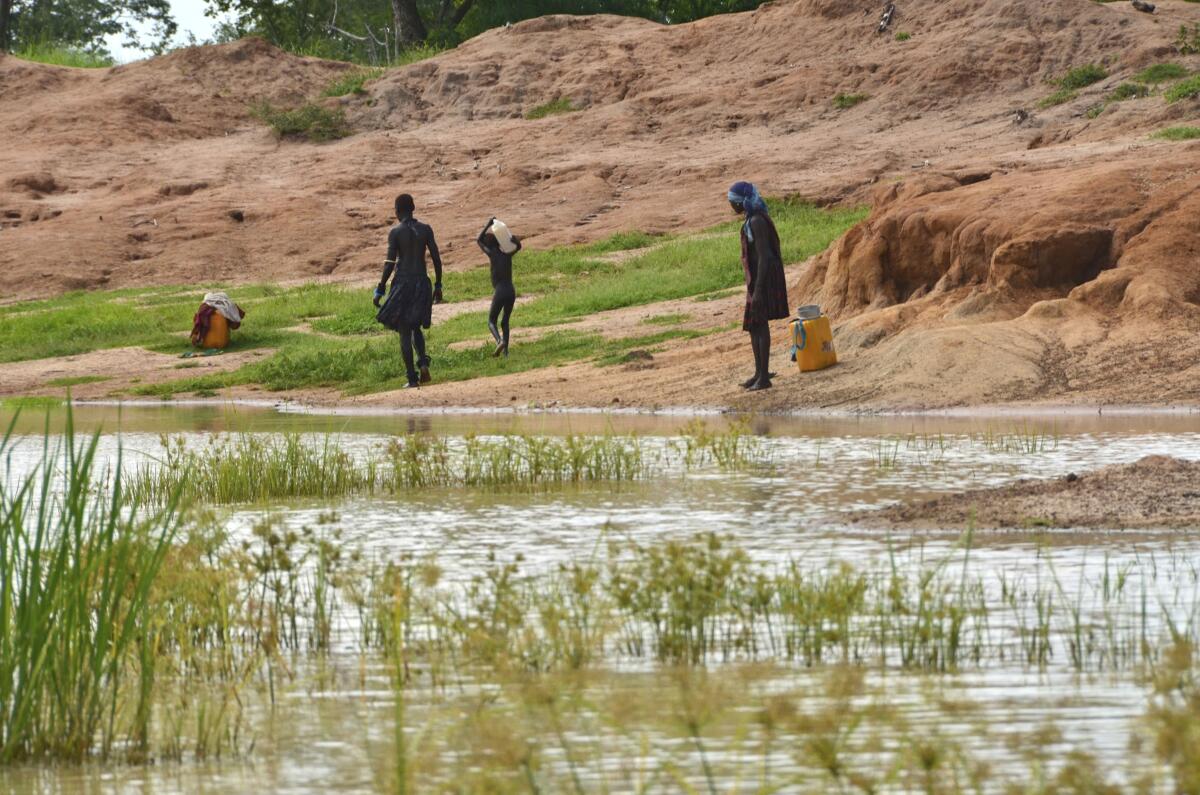
With his presidency behind him, Carter had more freedom. He made eliminating Guinea worm one of the Carter Center’s priorities, along with five other preventable diseases: river blindness, trachoma, schistosomiasis, lymphatic filariasis and malaria.
At first, engaging foreign leaders was a challenge because Guinea worm is mostly a rural affliction.
“We found nobody else wanted to deal with this disease because it affects isolated villages in the desert areas and also in the jungle areas,” Carter said to the Commonwealth Club of California.
When Hopkins went from the U.S. Centers for Disease Control and Prevention to the Carter Center to direct the Guinea Worm Eradication Program, Carter would constantly tell him he was not calling him enough to ask for his help.
“I didn’t want to bother a former president of the United States every time I ran into a problem in one country or another; I tried to save that big thing for the big problems,” Hopkins said. “But he insisted.”
As Carter worked closely with ministries of health, local volunteers and organizations such as the CDC and the World Health Organization, the Guinea worm case count plummeted from the 3.5 million in 1986 to 623,579 in 1990 to 75,223 in 2000.
The disease was eradicated in 17 countries, including Pakistan, Kenya, India, Yemen, Senegal and Cameroon.
In some regions, the program was stalled by civil war. But in some cases, the push to eradicate the Guinea worm helped foster peace.
In 1995, Carter negotiated a four-month “Guinea Worm Cease-Fire” in the Sudanese civil war, the longest humanitarian cease-fire in history at the time, allowing health workers to access almost 2,000 endemic villages and distribute water filters. Until then, the center’s strategy had been to wait until the end of the civil war before embarking on its public health mission.
For a while, it looked as though Carter would outlive the last Guinea worm. But in 2012, the program experienced a setback: The parasite was spreading among stray dogs in Chad, a nation that had gone a decade without human infections.
Health workers introduced new measures such as chaining infected dogs to keep them out of water, which has significantly reduced transmission among canines. In 2022, six provisional human cases were reported in Chad, five in South Sudan, one in Ethiopia, and one in the Central African Republic.
Weiss said he and his colleagues at the Carter Center— along with more than 30,000 volunteers working in areas under active surveillance — are determined to continue Carter’s legacy.
“He said let’s get it done before I leave planet Earth, and that has certainly given us a lot of motivation,” Weiss said. “We keep doubling down the attention and rigor as eradication demands. You miss one case, and you can be set back years, so we don’t take that lightly, and neither did he.”
More to Read
Sign up for Essential California
The most important California stories and recommendations in your inbox every morning.
You may occasionally receive promotional content from the Los Angeles Times.












